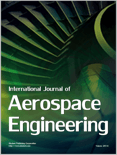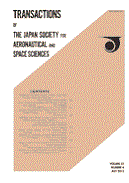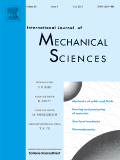
PROGRESS IN AEROSPACE SCIENCES
Scope & Guideline
Fostering global connections in the aerospace community.
Introduction
Aims and Scopes
- Crashworthiness and Safety Design:
A significant focus on crashworthiness design and evaluation of aircraft structures, ensuring occupant survivability and safety during aviation accidents. - Advanced Materials and Manufacturing Techniques:
Research on materials such as carbon fiber composites and additive manufacturing processes, highlighting their applications in aerospace structures and components. - Aerodynamics and Fluid Dynamics:
A comprehensive examination of aerodynamics, including flow dynamics, shock wave interactions, and innovative approaches to enhance performance and efficiency in aerospace systems. - Propulsion Systems and Technologies:
In-depth studies on various propulsion systems, including hybrid-electric and advanced combustion technologies, addressing both performance and environmental impacts. - Autonomous Systems and Control:
Exploration of autonomous systems in aerospace applications, including cooperative control methods for aerial and ground systems, enhancing operational efficiency and safety. - Sustainability in Aviation:
A commitment to addressing sustainability challenges in aviation, reviewing technologies and strategies for reducing environmental impacts and achieving net-zero emissions. - Space Exploration and Satellite Technologies:
Research on emerging trends in space exploration, satellite technology, and space situational awareness, contributing to advancements in the space domain.
Trending and Emerging
- Sustainable Aviation Technologies:
There is a marked increase in research dedicated to sustainable aviation, including studies on hydrogen-powered aircraft, hybrid-electric systems, and sustainable fuel sources, reflecting a global push towards reducing aviation's carbon footprint. - Additive Manufacturing and Advanced Materials:
The exploration of additive manufacturing techniques and advanced materials continues to gain traction, with a focus on optimizing designs for performance and weight reduction in aerospace applications. - Artificial Intelligence and Machine Learning Applications:
The integration of AI and machine learning techniques in various aspects of aerospace engineering, from design optimization to predictive maintenance, is emerging as a critical area of research. - Autonomous and Cooperative Systems:
Increasing interest in autonomous systems and cooperative motion planning emphasizes the development of advanced control algorithms for both aerial and ground vehicles. - Space Domain Awareness and Cislunar Exploration:
Research focusing on space situational awareness and the exploration of cislunar space is gaining importance, driven by advancements in satellite technologies and the growing interest in lunar missions.
Declining or Waning
- Conventional Aircraft Design Approaches:
Traditional methodologies in aircraft design, particularly those that do not incorporate advanced materials or sustainable practices, appear to be less prominent as the field shifts towards innovative and environmentally friendly solutions. - Static Aerodynamics Studies:
Research focusing solely on static aerodynamic properties is declining in favor of dynamic studies that account for real-world conditions and advanced computational methods. - Basic Propulsion Concepts:
Basic studies of conventional propulsion systems are waning as researchers increasingly focus on hybrid, electric, and alternative propulsion technologies that offer improved efficiency and reduced environmental impact.
Similar Journals

CEAS Space Journal
Connecting research and innovation in the realm of space.CEAS Space Journal, published by SPRINGER WIEN, serves as a critical platform for advancing knowledge in the fields of aerospace engineering and space science. With an ISSN of 1868-2502 and an E-ISSN of 1868-2510, this journal has been at the forefront of scholarly communication since its inception in 2011, showcasing cutting-edge research that spans to the present day (2024). The journal holds a solid reputation, ranking in the Q2 quartile for Aerospace Engineering and Q3 for Space and Planetary Science as of 2023, illustrating its impactful contributions within these disciplines. Scopus rankings further underline its prominence, placing it in the 70th percentile among aerospace engineering journals. Although it is not an open access publication, the insights published in the CEAS Space Journal are invaluable for researchers, professionals, and students alike, providing essential studies and reviews that push the boundaries of aerospace innovation and planetary exploration. The journal's commitment to quality and rigor makes it an indispensable resource for anyone looking to deepen their understanding of contemporary challenges and technological advancements in space science.

International Journal of Aeronautical and Space Sciences
Pioneering Insights in Aerospace EngineeringThe International Journal of Aeronautical and Space Sciences, published by Springer, is a prominent platform dedicated to advancing research and innovation in the fields of Aerospace Engineering, Control and Systems Engineering, Electrical and Electronic Engineering, and Materials Science. With an ISSN of 2093-274X and an E-ISSN of 2093-2480, the journal has established itself as a vital resource since its inception in 2011, currently offering insights that span a wide range of contemporary challenges and technological advancements in aeronautics and space exploration. Ranking in the Q2 category across multiple disciplines, including Aerospace and Control Engineering, signifies its recognized impact and quality within the academic community. Although not an open-access journal, it remains accessible to researchers, professionals, and students seeking to enhance their understanding of complex aerospace systems and their applications. The journal’s commitment to publishing high-quality research makes it indispensable for those aiming to contribute to, or stay informed about, the evolving landscape of aerospace technology.

International Journal of Aerospace Engineering
Unlocking Potential in Aerospace EngineeringThe International Journal of Aerospace Engineering, published by HINDAWI LTD, stands at the forefront of innovation and research in the field of aerospace engineering. With an impact factor reflecting its contributions to the discipline and classified in Quartile 3 (Q3) for the year 2023, this journal provides a platform for high-quality, peer-reviewed articles that delve into advancements and challenges in aerospace technology and applications. Since its inception in 2008, the journal has embraced an Open Access model, promoting unrestricted dissemination of research findings to foster collaboration and knowledge sharing among researchers, professionals, and academia. The journal covers a broad spectrum of topics, aiming to enhance understanding and give insight into aerospace engineering's multifaceted aspects. With its coverage in the Scopus database, ranking 71 out of 153 in the aerospace engineering category, the journal is a valuable resource for those engaged in this dynamic field, ensuring that high-impact research receives the visibility it deserves.

Advances in Aircraft and Spacecraft Science
Transforming Ideas into Aerospace SolutionsAdvances in Aircraft and Spacecraft Science is a distinguished journal published by TECHNO-PRESS, focusing on the rapidly evolving fields of aerospace engineering and fluid dynamics. With an ISSN of 2287-528X and an E-ISSN of 2287-5271, this journal is an invaluable resource for researchers, professionals, and students dedicated to advancing knowledge in aircraft and spacecraft technologies. Established in 2014, the journal is committed to disseminating high-quality research findings and innovative methodologies, ensuring that cutting-edge studies can be accessed globally. Despite its current position in the Q4 category for both aerospace engineering and fluid flow transfer processes, it continues to carve a niche in the academic landscape, with Scopus rankings highlighting its contribution to these fields. Operating from South Korea, Advances in Aircraft and Spacecraft Science aims to inspire collaboration and knowledge-sharing among scholars, fostering advancements that drive the aerospace industry forward.

Journal of the Korean Society for Aeronautical and Space Sciences
Unveiling Breakthroughs in Space ScienceThe Journal of the Korean Society for Aeronautical and Space Sciences is a dedicated platform for the dissemination of cutting-edge research in the fields of aerospace engineering and space sciences. Published by the esteemed Korean Society for Aeronautical & Space Sciences, this journal aims to bring together innovative findings and technological advancements from around the globe, thereby contributing to the ongoing development of the aerospace sector. Operating from South Korea, the journal holds an ISSN of 1225-1348 and an E-ISSN of 2287-6871, catering to both print and digital scholarly communication. Although categorized in Q4 within the Aerospace Engineering segment and ranked 139 out of 153 on Scopus, the journal plays a crucial role in fostering research collaboration and knowledge exchange among professionals, researchers, and students alike. With converged years from 2019 to 2024, it continuously seeks to enhance its contributions to the academic community through rigorous peer review and publication of original research. Given the evolution of aerospace technologies, this journal is vital for anyone involved in aeronautical research, ensuring that their work reaches the right audience.

TRANSACTIONS OF THE JAPAN SOCIETY FOR AERONAUTICAL AND SPACE SCIENCES
Charting New Paths in Aeronautical ResearchTRANSACTIONS OF THE JAPAN SOCIETY FOR AERONAUTICAL AND SPACE SCIENCES is a distinguished journal published by the Japan Society for Aeronautical and Space Sciences, focusing on the latest advancements and research in the fields of aerospace engineering and space and planetary science. With a broad range covering theoretical studies, practical applications, and experimental research, this journal serves as a vital platform for researchers, professionals, and students keen to explore the intricacies of aeronautics and space technologies. Although currently closed to open access, the journal maintains a significant presence in the academic community, boasting a 2023 Scopus ranking of Q3 in both of its respective fields and offering insights that contribute to ongoing discussions and innovations in aerospace. Since its inception in 1969 and with publications extending to 2024, the journal not only reflects the evolving landscape of aeronautics and space sciences but also encourages discourse that paves the way for future breakthroughs. For your engagement and contributions to this dynamic field, the TRANSACTIONS OF THE JAPAN SOCIETY FOR AERONAUTICAL AND SPACE SCIENCES stands as an essential resource.

Space: Science & Technology
Charting the Course for Future Space ExplorationSpace: Science & Technology is a premier, open-access journal published by the American Association for the Advancement of Science, dedicated to advancing knowledge in the rapidly evolving fields of aerospace engineering and space sciences. Since its inception in 2021, the journal has rapidly established itself as a vital resource, achieving an impressive Q1 ranking in Aerospace Engineering and Q2 ranking in Space and Planetary Science as of 2023. With a Scopus rank placing it 45th out of 153 in Aerospace Engineering and 47th out of 104 in Space and Planetary Science, it serves as a critical platform for researchers, engineers, and students alike to disseminate their findings and engage with the latest developments in their field. The journal encourages innovative research articles, technical notes, and reviews that push the boundaries of what's possible in space exploration and technology. With its commitment to open access since 2021, Space: Science & Technology ensures that pioneering research is readily available to a global audience, promoting collaboration and knowledge sharing in an increasingly interconnected scientific community.

INTERNATIONAL JOURNAL OF MECHANICAL SCIENCES
Pioneering Research for a Mechanical FutureThe INTERNATIONAL JOURNAL OF MECHANICAL SCIENCES, published by PERGAMON-ELSEVIER SCIENCE LTD, stands as a premier platform for groundbreaking research in the field of engineering and applied sciences. With an impressive convergence of scholarly work from 1960 to 2024, the journal maintains its position in the elite Q1 quartile across several categories, including Aerospace Engineering, Mechanics of Materials, and Ocean Engineering, among others. Its esteemed rank within the Scopus database further underscores its vital role in advancing knowledge in Mechanical Engineering and related disciplines, holding ranks in the top percentiles. While it operates on a subscription basis, the journal prioritizes delivering high-quality, peer-reviewed articles that not only inform but also inspire innovation within academia and industry alike. The INTERNATIONAL JOURNAL OF MECHANICAL SCIENCES is an essential resource for researchers, professionals, and students aiming to deepen their understanding and contribute to the dynamic landscape of mechanical sciences.

Journal of Aerospace Technology and Management
Empowering Aerospace Professionals with Cutting-edge Insights.The Journal of Aerospace Technology and Management, published by the Instituto de Aeronáutica e Espaço (IAE), serves as a pivotal platform for the dissemination of innovative research in the fields of Aerospace Engineering and Computational Mechanics since its inception in 2009. With an ISSN of 1984-9648 and an E-ISSN of 2175-9146, this Open Access journal facilitates unrestricted access to quality research, fostering knowledge sharing and collaboration among researchers, professionals, and academic institutions worldwide. Based in Brazil, it ranks in the Q3 category according to the latest metrics (2023), highlighting its growing influence and relevance in the competitive landscape of aerospace studies. The journal currently boasts notable Scopus rankings, ensuring that published works achieve widespread recognition and impact within the scientific community. Its diverse scope encompasses a blend of theoretical and applied research, making it an indispensable resource for those seeking to explore groundbreaking advancements in aerospace technologies and management.

Propulsion and Power Research
Driving Progress in Fluid Flow and Transfer Processes.Propulsion and Power Research, published by KEAI PUBLISHING LTD, is a leading Open Access journal that has been advancing the field of propulsion and power systems since its inception in 2012. With its commitment to fostering scientific discourse and innovation, the journal has gained a prominent position within academia, achieving a Q1 ranking in multiple categories such as Aerospace Engineering, Automotive Engineering, and Fluid Flow and Transfer Processes as of 2023. With an impressive ranking of #18 out of 153 in Aerospace Engineering and consistent recognition in the Scopus rankings, the journal explores critical advancements and research findings that propel the industry forward. As an Open Access publication, it ensures that groundbreaking research is readily available to a broad audience, enhancing collaboration between researchers, practitioners, and students. The journal's scope encompasses a wide range of topics within propulsion and energy solutions, making it an essential resource for anyone keen on discovering significant developments in this dynamic field.